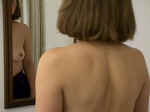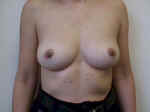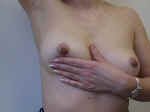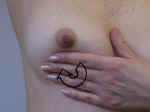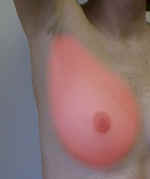Operational Obstetrics & Gynecology
Self Breast Exam
Breast self examination is an important, potentially life-saving procedure. It should be known and practiced by all women. Because the majority of breast masses are detected by women themselves, monthly self breast examination, in combination with regular, annual, professional examinations and periodic mammography offers the best chance of reducing the risks of advanced breast cancer.
The best time to examine the breasts is immediately following a menstrual period. The breasts are the smoothest (least lumpy) and easiest to examine at this time. The completion of a menstrual period is a convenient reminder to examine the breasts.
Begin with a close inspection of the breasts in the mirror.
With your arms at your side, look for any dimpling or unusual skin changes. There should be no visible bumps or bulges of the breast beyond the normal contour.
The skin should be a uniform color and not have areas of redness suggesting increased blood flow.
The nipples should have no visible secretions or crusting.
Watch in the mirror as you raise your arms over your head. The breasts should rise and there should be no change in shape.
Some breast problems cause a portion of the breast to become adherent to the chest wall. In such cases, when the arms are raised, the "stuck" portion of the breast remains in place while the rest of the breast rises. This causes "dimpling" or "retraction" of the skin over the stuck portion of the breast.
With one arm raised begin feeling for lumps or masses with the opposite hand.
Raising the arm is helpful because it stretches the pectoralis major muscle (the large muscle under the breast) and lifts the breast up, creating a more solid, smooth surface on which to examine the breast.
All breasts feel a little "lumpy," but remember that you are not feeling for tiny nodules, but rather for larger lumps. You are feeling for "a marble in a bag of rice."
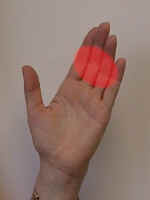 Use the Mid-portion of your Fingers
Use the Mid-portion of your Fingers
Don't use your fingertips...they are too sensitive and you will end up focusing on all the tiny irregularities and nodules that are present in everyone's breasts.
Don't use the palms of your hand...they are too insensitive and you can miss something important.
Use the middle portions of your fingers...they have just the right sensitivity for finding the lumps or masses you are seeking.
Move your hand in small circles while feeling for lumps.
By compressing the breast tissue between your fingers and your chest wall, while moving your hand in small circles, you will be able to feel the fine nodularity of your breast, and also detect any changes in that nodular feeling.
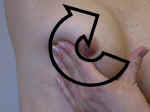 Move to Another area of the Breast
Move to Another area of the Breast
After examining the first area with circular motions of your hand, move to another area and again feel for lumps, using a circular motion. Many people find it easiest to progress in a clock-wise fashion around the breast until the entire breast has been examined.
Remember that the breast is not perfectly round, but has an extension ("tail") that extends up into the armpit. It is important to examine that portion of the breast too.
Of all breast lumps that are found, more arise in the upper outer quadrant and tail than any other area.
Feel for Lumps in the Armpit
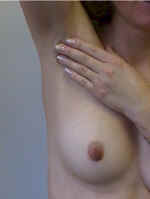 Using the same circular motions, examine the armpit, feeling for any lumps in the
"tail" of the breast or any lymph nodes.
Using the same circular motions, examine the armpit, feeling for any lumps in the
"tail" of the breast or any lymph nodes.
Lymph nodes are normally so small they cannot be felt. If enlarged due to infection or inflammation, they grow to about the size of a pencil eraser but are long and narrow rather than round.
Check for Nipple Discharge
Using the thumb and fingers, squeeze the breast toward the nipple to try to express any discharge. This stripping of the milk ducts can be useful in identifying early problems with the ducts. You should squeeze not only from side to side, but also from top to bottom and at an angle.
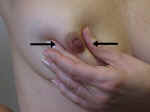 In normal breasts, you can, with effort, usually produce a drop or two of clear, milky,
or slightly green-tinged discharge. Abnormal findings would be a bloody discharge, or so
much discharge that it squirts across the room or consistently stains the inside of your
bra.
In normal breasts, you can, with effort, usually produce a drop or two of clear, milky,
or slightly green-tinged discharge. Abnormal findings would be a bloody discharge, or so
much discharge that it squirts across the room or consistently stains the inside of your
bra.
Check the Opposite Side
Then move to the other breast, performing the same maneuvers. Make sure to remember to raise your arm over your head to stretch the muscles underneath the breast.
Annual Professional Examinations
In addition to your monthly breast self-examinations, an annual professional exam by a physician or other qualified health professional is important.
At that time, you can ask questions about findings that you didn't consider abnormal but were nonetheless troubling.
Mammography is the final part of routine breast screening.
For women without significant breast disease or a family history of breast cancer , mammography is probably useful about every other year from age 40 to age 50. After age 50, most health providers recommend annual mammograms.
For women with specific risk factors, mammography more often may be recommended.
Check with your own health care provider to find out what would be best for you.
Don't panic.
Most (90%) are benign, innocent abnormalities that often will go away by themselves. Others will need treatment or removal, but with complete resolution of the problem.
For those few that are cancerous, early treatment leads to the best possible outcome, so make sure to see your health care provider right away.
Home · Introduction · Medical Support of Women in Field Environments · The Prisoner of War Experience · Routine Care · Pap Smears · Human Papilloma Virus · Contraception · Birth Control Pills · Vulvar Disease · Vaginal Discharge · Abnormal Bleeding · Menstrual Problems · Abdominal Pain · Urination Problems · Menopause · Breast Problems · Sexual Assault · Normal Pregnancy · Abnormal Pregnancy · Normal Labor and Delivery · Problems During Labor and Delivery · Care of the Newborn
|
Bureau of Medicine
and Surgery |
Operational
Obstetrics & Gynecology - 2nd Edition |
 This
web version of Operational Obstetrics & Gynecology is provided by
The Brookside Associates
Medical Education Division. It contains original contents from the
official US Navy NAVMEDPUB 6300-2C, but has been reformatted for web access and
includes advertising and links that were not present in the original version.
This web version has not been approved by the Department of the Navy or the
Department of Defense. The presence of any advertising on these pages does not
constitute an endorsement of that product or service by either the Department of
Defense or the Brookside Associates. The Brookside Associates is a private
organization, not affiliated with the United States Department of Defense. All
material in this version is unclassified.
This
web version of Operational Obstetrics & Gynecology is provided by
The Brookside Associates
Medical Education Division. It contains original contents from the
official US Navy NAVMEDPUB 6300-2C, but has been reformatted for web access and
includes advertising and links that were not present in the original version.
This web version has not been approved by the Department of the Navy or the
Department of Defense. The presence of any advertising on these pages does not
constitute an endorsement of that product or service by either the Department of
Defense or the Brookside Associates. The Brookside Associates is a private
organization, not affiliated with the United States Department of Defense. All
material in this version is unclassified.
This formatting © 2006
Medical Education Division,
Brookside Associates, Ltd.
All rights reserved
